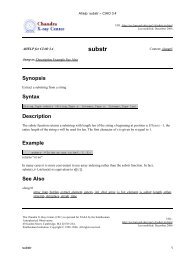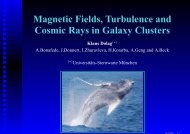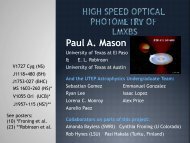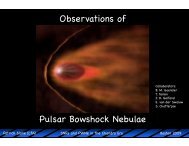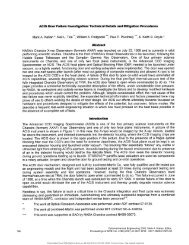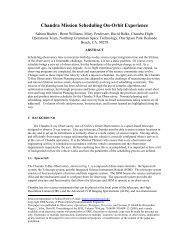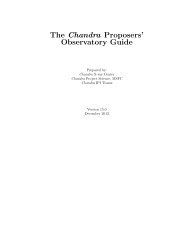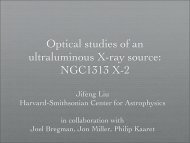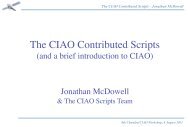PDF Version - Chandra X-Ray Observatory (CXC)
PDF Version - Chandra X-Ray Observatory (CXC)
PDF Version - Chandra X-Ray Observatory (CXC)
Create successful ePaper yourself
Turn your PDF publications into a flip-book with our unique Google optimized e-Paper software.
26<br />
these updates will alleviate some of the uncertainty. We<br />
took a hard look at the Fellowship Terms and Conditions<br />
and decided that we could add wording allowing for up<br />
to 12 weeks of unpaid leave for family or medical reasons.<br />
This brings us in-line with the Family and Medical<br />
Leave Act. Since Fellows are not employees but receive a<br />
stipend, in practice this means that we “stop the clock”<br />
for up to 12 weeks and extend the Fellowship beyond the<br />
nominal stop date. We hope this will give some flexibility<br />
to deal with family issues.<br />
Einstein Fellows have had some notable successes<br />
over the past year. Eran Ofek (2009) has moved back to<br />
Israel to take up a faculty position at the Weizmann Institute<br />
of Science. Nico Yunes (2010) and Dovi Poznanski<br />
(2010) have accepted faculty positions at Montana State<br />
University and Tel Aviv University in Israel respectively.<br />
Tamara Bogdanovic (2010) has been offered a faculty<br />
position at Georgia Tech School of Physics upon completion<br />
of her fellowship. When I read the end of year<br />
reports I’m always astonished by the productivity of our<br />
Fellows, but two recent papers merit special mention.<br />
Matthew Kerr (2011), Robin Corbet, Teddy Cheung,<br />
and the Fermi LAT collaboration have a recent (January<br />
2012) paper in Science reporting on the discovery<br />
of periodic emission from the gamma-ray binary 1FGL<br />
J1018.6-5856. This object is one of only three gamma<br />
binaries known and the first to be discovered by the LAT<br />
by searching for a period. The work of Kevin Schawinski<br />
(2009) describing a “young” supermassive black hole was<br />
showcased in a recent press release from Yale University<br />
(http://news.yale.edu/2011/12/01/yale-discovery-youngsupermassive-black-holes-challenges-current-theory).<br />
Congratulations to all the Fellows on a great year, and<br />
we’re looking forward to 2012!<br />
Got Data—Will Publish!<br />
Arnold Rots, Sherry Winkelman,<br />
Glenn Becker<br />
The <strong>Chandra</strong> Data Archive’s bibliography database<br />
(http://cxc.harvard.edu/cgi-gen/cda/bibliography) provides<br />
its users not only with a powerful research tool, it<br />
also allows us to track what happens to all the valuable<br />
<strong>Chandra</strong> observations.<br />
Rather than asking how many papers were published<br />
on <strong>Chandra</strong> observations or how many citations<br />
they received, we started wondering how much of the<br />
<strong>Chandra</strong> data actually result in refereed journal articles<br />
and how often. After a fair bit of experimentation we<br />
<strong>CXC</strong> Newsletter<br />
constructed the graph in Fig. 1. It shows what fraction<br />
of the available <strong>Chandra</strong> exposure time was published—<br />
once, twice, thrice, or more often—as a function of the<br />
data’s age, in steps of one year.<br />
The figure represents the status on 1 August<br />
2011 and includes all non-calibration and non-engineering<br />
observations that were made prior to 1 August 2010.<br />
More precisely, it shows what percentage of exposure<br />
time that has been available for N years or more, was<br />
presented in a paper in a refereed journal, N years after<br />
the observation was first released to the PI.<br />
It turns out that this figure, notwithstanding its<br />
simplicity, yields a lot of information:<br />
• Second publications start about a year after the first,<br />
indicative of the common one-year proprietary period.<br />
• It takes about two and a half years for half the data to<br />
be published.<br />
• After four years the curve starts to flatten.<br />
• At seven years about 85% of the data have been published<br />
and we have nearly reached an equilibrium. This<br />
is a very high percentage.<br />
• Also at seven years, 50% of the data have been published<br />
more than twice, indicative both of the popularity<br />
of the archive, and the utility of the data.<br />
• Beyond ten years the percentage of data published exceeds<br />
90%. However, since that range pertains pretty<br />
much to the data from the early days of the mission, we<br />
are curious to see whether such a percentage will be sustained<br />
for the later years, too.<br />
Similar statistics are not available for other missions<br />
or observatories, but we are confident that the high<br />
percentage of data that gets published represents a high<br />
score, confirming that <strong>Chandra</strong> data are judged extremely<br />
valuable by its user community. Similarly, the statistics<br />
on multiple publications is indicative of the intensive use<br />
that the community makes of the <strong>Chandra</strong> Data Archive.<br />
A more extensive paper on the <strong>Chandra</strong> publication<br />
statistics will appear in the April 2012 issue of PASP<br />
(Volume 124, No. 914).<br />
This kind of information is available thanks to<br />
the extensive bibliographic database that the Archive<br />
Operations Team maintains. We are grateful for the help<br />
we receive from users who provide in their papers explicit<br />
information on which observations they use. We<br />
would like to encourage all <strong>Chandra</strong> Guest Observers<br />
and users of the <strong>Chandra</strong> Data Archive to follow their<br />
example or, even better, to embed Dataset Identifiers in<br />
their manuscripts (see http://cxc.cfa.harvard.edu/cda/<br />
datasetid.html).



